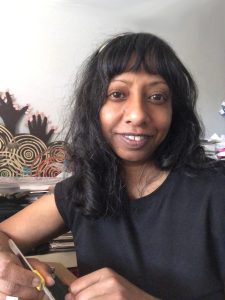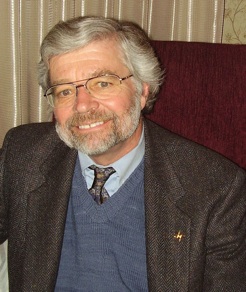Careful/Care-full Collaboration
Call for Submissions
Editors: Maria Hamilton Abegunde and Mita Mahato
Managing Editor: Michael McDermott
Open for submissions on January 1, 2025
All submissions are due by March 10, 2025
Issue to be published May 2025
Careful/Care-full Collaboration
Creative collaboration is an opportunity to summon and practice ways of being in the world and with each other that challenge myths of exceptional individualism as constructed within colonial and capitalist contexts. This type of collaboration can acknowledge and affirm that making art is not an isolated event, and has the potential to share and/or redefine power between artists and the communities in/with which they work. The dynamic and responsive work that emerges from entangling minds, perspectives, and positionalities speaks and models on the page or screen, through the body or soundwaves, the care and imagination that is integral to community building and kin-making. Creative collaboration is a method and commitment to seeding and nurturing webs of knowledge, histories, practices, and relationships with each other and the places that are sacred to us.
Guided by this understanding, the Spring 2025 issue of About Place Journal invites submissions that contemplate what it means to collaborate with others through practices and processes that are careful and care-full, that is collaborations that are cautious at various stages and shaped by an ethics of care between the artists, for their communities, and throughout the process of co-creating. Submissions are open January 1 – March 10, 2025.
Keeping in mind the core values of the Black Earth Institute to use Art to “promote an understanding of the interconnectedness of all living beings and this earth we share” and to “work toward a society based on Justice, Spirit, and Earth Centeredness…” this issue invites joint submissions from artistic collaborators that make transparent the practices, processes, and creations that connect them to each other, honor the earth, engage with spirit, and promote/fight for justice in ways that require careful and care-full attention to individual and communal needs and desires.
We are interested in submissions that define community and care, and that consider how/why collaboration necessitates careful or care-full approaches to creating, re-vision relationships with art, artists, community, nature, and/or the divine.
Questions to explore include, but are not limited to: How does collaboration lead to care and what connects the two? How does conflict within collaboration lead to new ways to care about each other? What practices shape your work as an individual? As a collaborative unit? As a community? How are care-focused interspecies or inter-technological collaborations imagined or practiced? How does engaging with spirit or the spirits shape your creative practice? How, when, and why do we share our work with each other?
We welcome your poetry, prose, visual art, audio, and hybrid forms of collaborative expression. Interviews, recorded dialogue, or other forms that document creative collaboration are also welcomed. Submissions from collaborative partners or groups will be prioritized over those of individuals.
Issue Editors

Maria Hamilton Abegunde
Dr. Abegunde is a memory keeper, poet, ancestral priest, and doula. She uses the arts, contemplative practices, and ritual to explore ways to heal trauma through community, collaborative, and co-creative practices. Her research, creative works, and teaching focus on memory, trauma, and healing, specifically related to the TransAtlantic Slave Trade, Middle Passage, genocide, and sexual violence in Black communities.
She is the creator of Stargazing: Re/Imagining the Life of Elizabeth “Lizzie” Breckenridge, a multi-media collaborative project that explores the life of Ms. Breckenridge at the Wylie House Museum (Bloomington, Indiana) during the 19th and 20th centuries. She is also the commissioned poet for the community, co-created and collaborative exhibitions Be/Coming, Keeper of My Mothers’ Dreams, and Sister Song: The Requiem. Her writings have been published in the Kenyon Review, Massachusetts Review, nocturnes, North Meridian Review, Obsidian, Tupelo Quarterly, and FIRE!!!; in the books ASHE: Ritual Poetics in African Diasporic Expressivity, Trouble the Waters: Tales from the Deep Blue, and SO WE CAN KNOW: Writers of Color on Pregnancy, Loss, Abortion, and Birth. Her fellowships for writing and research include Cave Canem, Sacatar, Ragdale, and NEH Summer Institute scholar.
She is a faculty member in the Department of African American and African Diaspora Studies at Indiana University Bloomington, and co-directed the 2024 NEH Summer Institute, Content Warning: Engaging Trauma and Controversy in Research Collections.

Mita Mahato
Dr. Mita Mahato is a comix artist and poet who assembles her panels and pages with cut and collaged papers. Her work joins fragments of used and discarded materials—old newspapers, obsolete maps, junk mail, packaging scraps—in poetic experiments that dramatize entangled processes of death and renewal, specifically within the context of ecosystemic loss under capitalism.
Her book Arctic Play is published by The 3rd Thing (2024) and her other poetry comix have appeared in places including PRISM, Ecotone, Iterant, Shenandoah, Coast/NoCoast, ANMLY, and Drunken Boat, as well as in the collection In Between, published by Pleiades and listed in The Best American Comics of 2019. Her work has been supported by Hanse-Wissenschaftskolleg (HWK), Helmholtz Institute for Functional Marine Biodiversity (HIFMB), Loghaven, Storyknife, Mineral School, Short Run Seattle, Seattle Office of Arts and Culture, and The Arctic Circle.
She teaches comics and poetry at all levels and currently lives in Seattle.
Managing Editor

Michael McDermott
Michael McDermott is a retired physician who spent many years in Emergency Medicine, becoming the Director of Adult Emergency Medicine at Cook County Hospital in Chicago. He was co-author on 20+ papers on improving asthma care. He retired to take a home in rural Dane County, Wisconsin, on 20 acres with an increasing portion as restored prairie. He has been a life-long activist, taking leadership positions in organizations. He met Patricia Monaghan in early 2004 and, faced with Bush’s second election, they formed the concept of the Black Earth Institute as a think tank for artists who take art in relation to spirit, earth and social justice. They launched the first group of fellows of BEI the next year. Michael’s land is named Brigit Rest after the Irish saint and goddess. Patricia died in 2012 but before that developed many projects built to promote Celtic spirituality. Michael continues as director of the Institute and is managing editor of About Place Journal.
About Place Journal Submission Guidelines
About Place Journal is published twice a year, in spring and fall. A new Call for Submissions is posted twice a year. Please review the current call and follow any specific genres called for in the upcoming issue.
Work can include:
- Poetry: up to 3 pieces which do not exceed 50 lines each. Acceptable file types include doc, docx, odt & rtf. If your poetry submission contains special formatting, we suggest submitting a PDF in addition to your Word doc.
- Fiction, essays, creative nonfiction and other prose: up to 3 pieces which do not exceed 4000 words each. Acceptable file types include doc, docx, odt & rtf.
- Audio/Visual/Hybrid artwork: up to 5 photographs, paintings, prints, comics pages, or other forms of A/V art (e.g. video essay, photo essay, spoken word). Acceptable file types include jpg & tif for still art; mp3, m4a, ogg & wav for audio; and avi, flv, m4v, mov, mp4, webm and wmv for video. Please include the size and media of each artwork with your list of works, if applicable. Visual work should not exceed 1275 px in width. Video and audio submissions should not exceed 10 minutes.
- The total number of submitted pieces cannot exceed 5, even if your submission includes items from several genre categories.
Please provide a numbered list with the title of each work you are submitting (1 to 5 works) in the field of the Submittable form where indicated. If you are submitting audio/visual artwork, please include the artwork size and media, if applicable, as part of your list.
Each submission must be accompanied by a document in doc, docx or rtf format that provides a bio for each collaborator or your group. Bios must be in the third person and not exceed 150 words each. A single artist statement, when relevant, may be included in this document and should also not exceed 150 words. Please include your website, Twitter and Instagram links if desired.
By submitting, you guarantee you hold the rights to the work, and you grant About Place Journal the rights to publish the submitted work with first serial rights (FNASR). After publication, rights revert to the author. Original, previously unpublished work only. All pieces must be submitted through Submittable, starting January 1, 2025.
